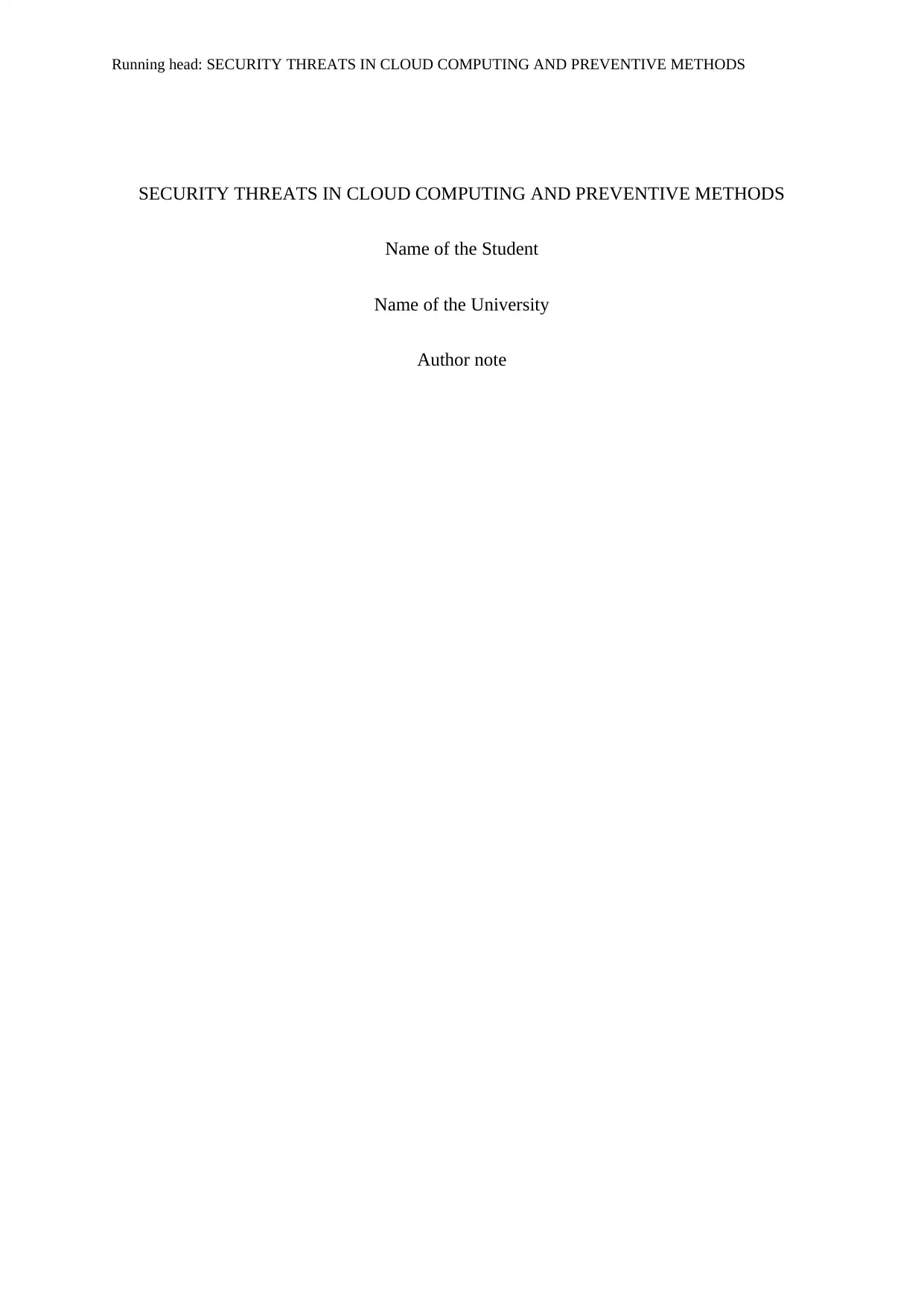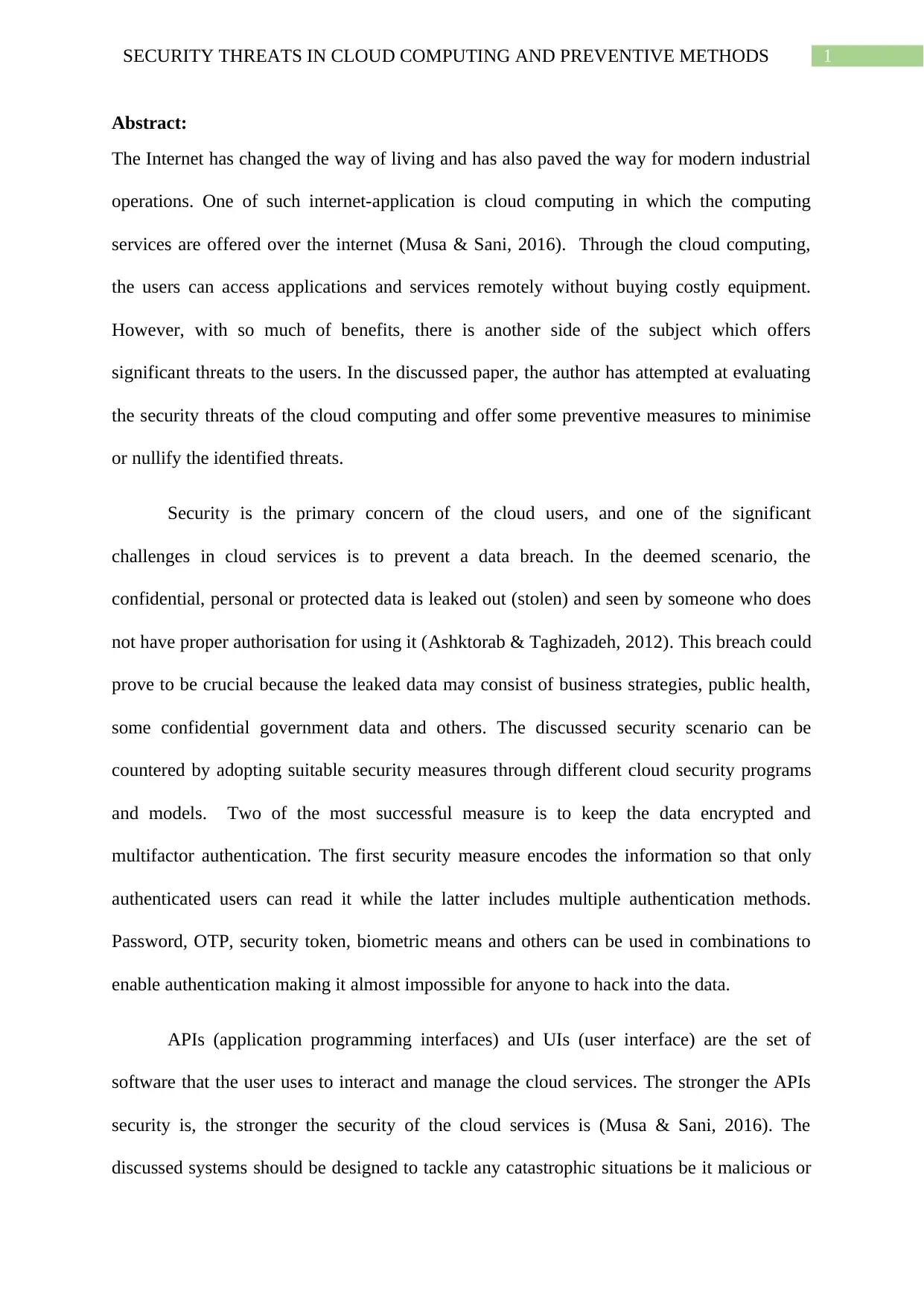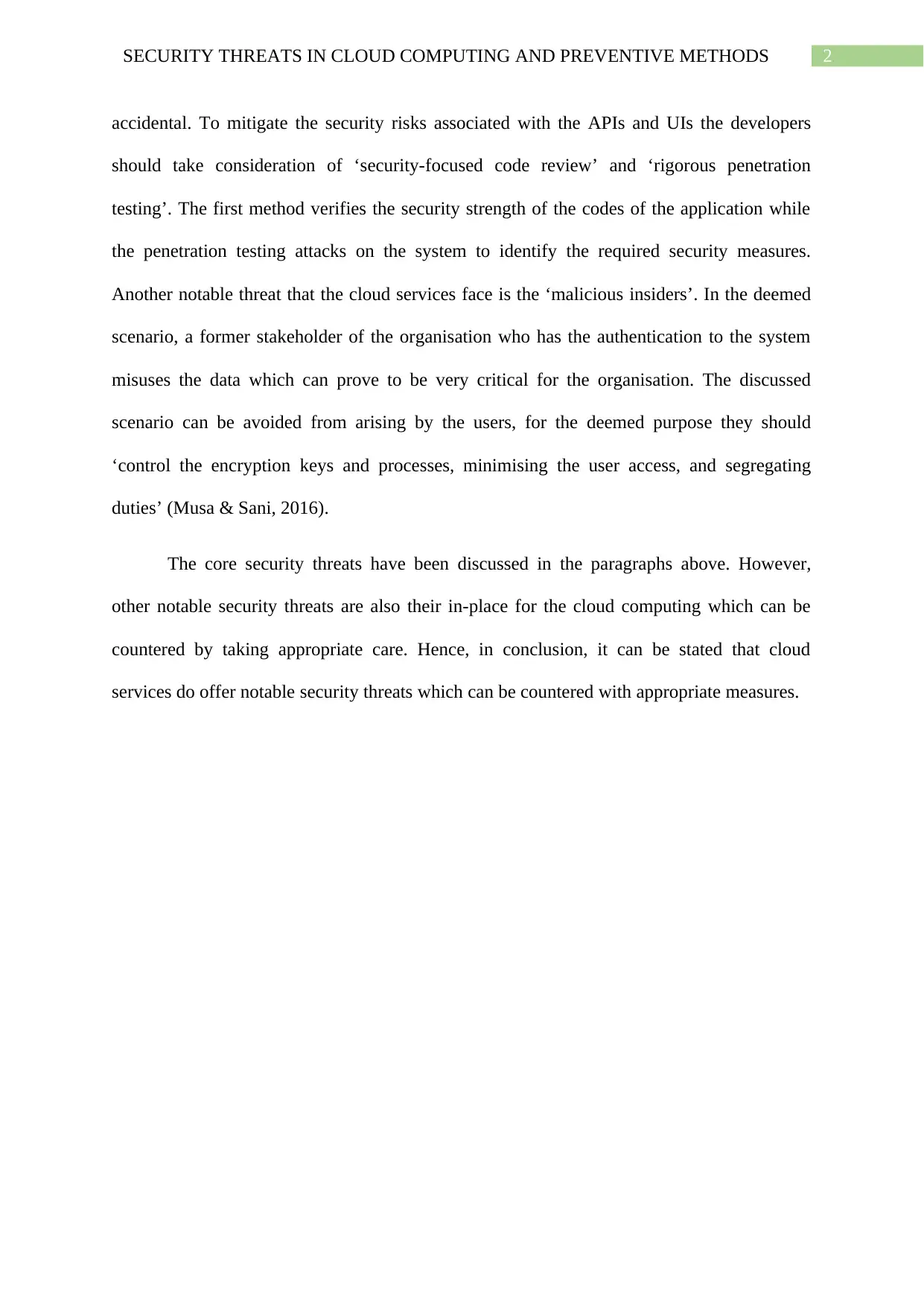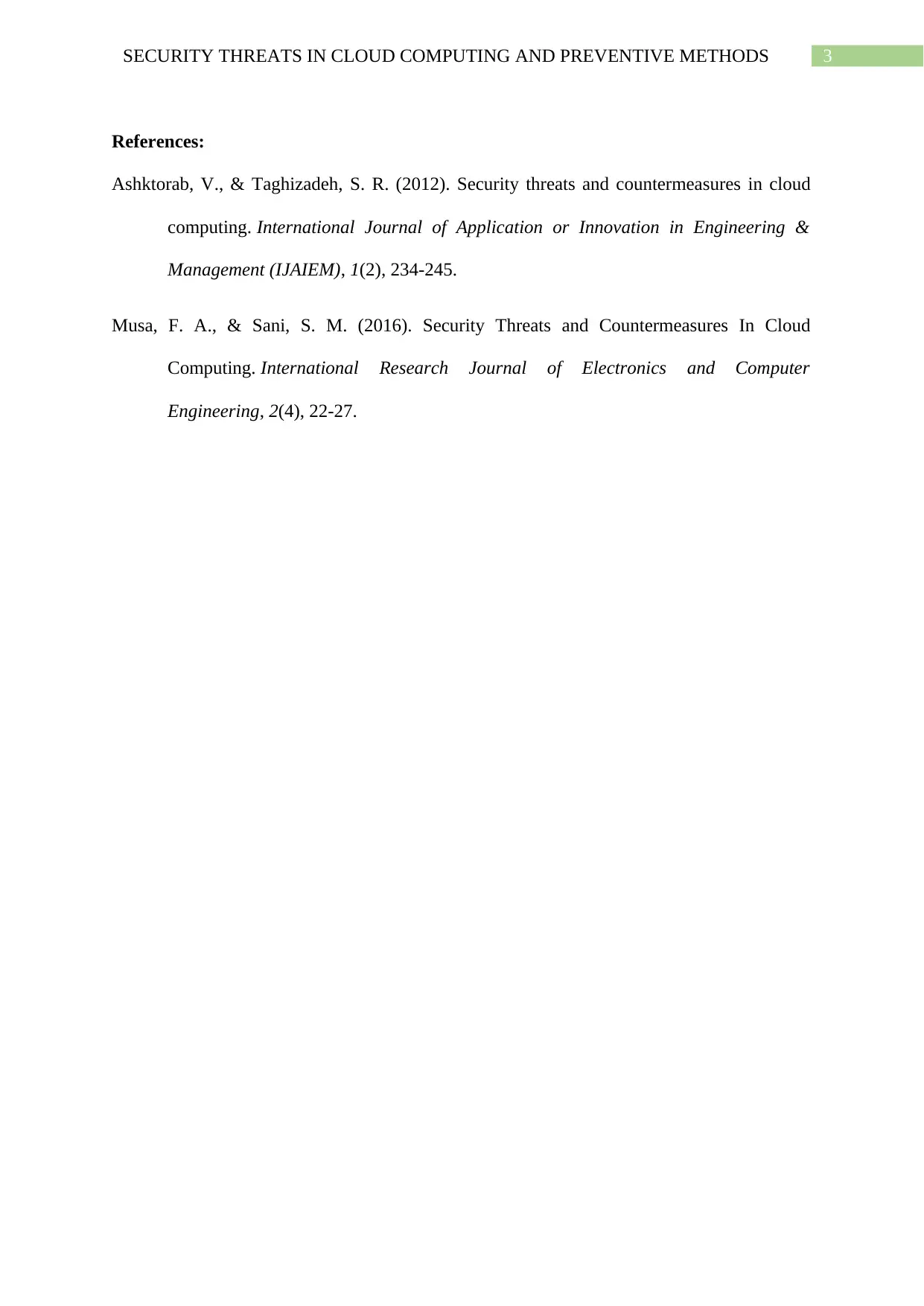Analysis of Security Threats in Cloud Computing & Prevention Methods
VerifiedAdded on 2023/06/12
|4
|715
|250
Report
AI Summary
This report evaluates security threats in cloud computing and proposes preventive measures. It highlights data breaches as a primary concern, emphasizing the importance of encryption and multi-factor authentication. The document also addresses API and UI security, advocating for security-focused code reviews and penetration testing. Furthermore, it discusses the threat of malicious insiders and suggests measures like controlling encryption keys and minimizing user access. The report concludes that while cloud services present security threats, appropriate measures can effectively counter them. This student contributed the document to Desklib.

Running head: SECURITY THREATS IN CLOUD COMPUTING AND PREVENTIVE METHODS
SECURITY THREATS IN CLOUD COMPUTING AND PREVENTIVE METHODS
Name of the Student
Name of the University
Author note
SECURITY THREATS IN CLOUD COMPUTING AND PREVENTIVE METHODS
Name of the Student
Name of the University
Author note
Paraphrase This Document
Need a fresh take? Get an instant paraphrase of this document with our AI Paraphraser

1SECURITY THREATS IN CLOUD COMPUTING AND PREVENTIVE METHODS
Abstract:
The Internet has changed the way of living and has also paved the way for modern industrial
operations. One of such internet-application is cloud computing in which the computing
services are offered over the internet (Musa & Sani, 2016). Through the cloud computing,
the users can access applications and services remotely without buying costly equipment.
However, with so much of benefits, there is another side of the subject which offers
significant threats to the users. In the discussed paper, the author has attempted at evaluating
the security threats of the cloud computing and offer some preventive measures to minimise
or nullify the identified threats.
Security is the primary concern of the cloud users, and one of the significant
challenges in cloud services is to prevent a data breach. In the deemed scenario, the
confidential, personal or protected data is leaked out (stolen) and seen by someone who does
not have proper authorisation for using it (Ashktorab & Taghizadeh, 2012). This breach could
prove to be crucial because the leaked data may consist of business strategies, public health,
some confidential government data and others. The discussed security scenario can be
countered by adopting suitable security measures through different cloud security programs
and models. Two of the most successful measure is to keep the data encrypted and
multifactor authentication. The first security measure encodes the information so that only
authenticated users can read it while the latter includes multiple authentication methods.
Password, OTP, security token, biometric means and others can be used in combinations to
enable authentication making it almost impossible for anyone to hack into the data.
APIs (application programming interfaces) and UIs (user interface) are the set of
software that the user uses to interact and manage the cloud services. The stronger the APIs
security is, the stronger the security of the cloud services is (Musa & Sani, 2016). The
discussed systems should be designed to tackle any catastrophic situations be it malicious or
Abstract:
The Internet has changed the way of living and has also paved the way for modern industrial
operations. One of such internet-application is cloud computing in which the computing
services are offered over the internet (Musa & Sani, 2016). Through the cloud computing,
the users can access applications and services remotely without buying costly equipment.
However, with so much of benefits, there is another side of the subject which offers
significant threats to the users. In the discussed paper, the author has attempted at evaluating
the security threats of the cloud computing and offer some preventive measures to minimise
or nullify the identified threats.
Security is the primary concern of the cloud users, and one of the significant
challenges in cloud services is to prevent a data breach. In the deemed scenario, the
confidential, personal or protected data is leaked out (stolen) and seen by someone who does
not have proper authorisation for using it (Ashktorab & Taghizadeh, 2012). This breach could
prove to be crucial because the leaked data may consist of business strategies, public health,
some confidential government data and others. The discussed security scenario can be
countered by adopting suitable security measures through different cloud security programs
and models. Two of the most successful measure is to keep the data encrypted and
multifactor authentication. The first security measure encodes the information so that only
authenticated users can read it while the latter includes multiple authentication methods.
Password, OTP, security token, biometric means and others can be used in combinations to
enable authentication making it almost impossible for anyone to hack into the data.
APIs (application programming interfaces) and UIs (user interface) are the set of
software that the user uses to interact and manage the cloud services. The stronger the APIs
security is, the stronger the security of the cloud services is (Musa & Sani, 2016). The
discussed systems should be designed to tackle any catastrophic situations be it malicious or

2SECURITY THREATS IN CLOUD COMPUTING AND PREVENTIVE METHODS
accidental. To mitigate the security risks associated with the APIs and UIs the developers
should take consideration of ‘security-focused code review’ and ‘rigorous penetration
testing’. The first method verifies the security strength of the codes of the application while
the penetration testing attacks on the system to identify the required security measures.
Another notable threat that the cloud services face is the ‘malicious insiders’. In the deemed
scenario, a former stakeholder of the organisation who has the authentication to the system
misuses the data which can prove to be very critical for the organisation. The discussed
scenario can be avoided from arising by the users, for the deemed purpose they should
‘control the encryption keys and processes, minimising the user access, and segregating
duties’ (Musa & Sani, 2016).
The core security threats have been discussed in the paragraphs above. However,
other notable security threats are also their in-place for the cloud computing which can be
countered by taking appropriate care. Hence, in conclusion, it can be stated that cloud
services do offer notable security threats which can be countered with appropriate measures.
accidental. To mitigate the security risks associated with the APIs and UIs the developers
should take consideration of ‘security-focused code review’ and ‘rigorous penetration
testing’. The first method verifies the security strength of the codes of the application while
the penetration testing attacks on the system to identify the required security measures.
Another notable threat that the cloud services face is the ‘malicious insiders’. In the deemed
scenario, a former stakeholder of the organisation who has the authentication to the system
misuses the data which can prove to be very critical for the organisation. The discussed
scenario can be avoided from arising by the users, for the deemed purpose they should
‘control the encryption keys and processes, minimising the user access, and segregating
duties’ (Musa & Sani, 2016).
The core security threats have been discussed in the paragraphs above. However,
other notable security threats are also their in-place for the cloud computing which can be
countered by taking appropriate care. Hence, in conclusion, it can be stated that cloud
services do offer notable security threats which can be countered with appropriate measures.
⊘ This is a preview!⊘
Do you want full access?
Subscribe today to unlock all pages.

Trusted by 1+ million students worldwide

3SECURITY THREATS IN CLOUD COMPUTING AND PREVENTIVE METHODS
References:
Ashktorab, V., & Taghizadeh, S. R. (2012). Security threats and countermeasures in cloud
computing. International Journal of Application or Innovation in Engineering &
Management (IJAIEM), 1(2), 234-245.
Musa, F. A., & Sani, S. M. (2016). Security Threats and Countermeasures In Cloud
Computing. International Research Journal of Electronics and Computer
Engineering, 2(4), 22-27.
References:
Ashktorab, V., & Taghizadeh, S. R. (2012). Security threats and countermeasures in cloud
computing. International Journal of Application or Innovation in Engineering &
Management (IJAIEM), 1(2), 234-245.
Musa, F. A., & Sani, S. M. (2016). Security Threats and Countermeasures In Cloud
Computing. International Research Journal of Electronics and Computer
Engineering, 2(4), 22-27.
1 out of 4
Related Documents
Your All-in-One AI-Powered Toolkit for Academic Success.
+13062052269
info@desklib.com
Available 24*7 on WhatsApp / Email
![[object Object]](/_next/static/media/star-bottom.7253800d.svg)
Unlock your academic potential
Copyright © 2020–2025 A2Z Services. All Rights Reserved. Developed and managed by ZUCOL.


